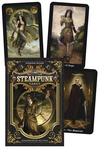Tarot: Group Dynamics Spread

As readers, heck, as humans, we are often asked for clarification about a situation. This technique and spread can help provide that clarification, if there is more than one person involved. In addition, it is meant to aid in understanding the other person (or people) involved so that the querent can develop the best plan to improve the situation or help progress a goal.
You'll need two decks for this. Specifically, you'll need two sets of Court cards.

- Divide your deck into three piles: Major Arcana, Court cards, and the rest of the Minor Arcana.
- Ask your querent to break down the situation and the people involved. As an example, let's say there is an issue at work, involving the querent who we'll call John and two co-workers, Ruth and Gordon.
- Ask John go through the Court cards from Deck A and select ones to represent each of the people involved: himself, Ruth, and Gordon. These should be cards that show how John sees each of the people in the situation, including himself. Discuss the characteristics with John. Lay the cards out in a horizontal line.
- Take up the other deck of Court cards (Deck B), shuffle, and randomly draw two to lay under John's card and one each to lay under Ruth's and Gordon's cards. The two under John's card shows how Ruth and Gordon, respectively, see John. The other cards show how Ruth and Gordon see themselves (or wish to be seen), respectively. In this way, we can see any discrepancies in perception. John may see Ruth as a reversed Queen of Cups. She may see herself as a King of Swords. There is a big difference between the two, and if John explores that, he can find ways to see the situation more fully and also, perhaps, from the point of the views of the others involved.
- Shuffle the Minor cards (without the Court cards) and lay one under each person's column. These cards show the aspect of the situation that is most important or troublesome to them. Again, if John is able to understand what is important to the others, he is more likely to figure out a workable solution.
- Shuffle the Major cards and lay one under each person's column. These cards represent the underlying issues that create the "button" that has been pushed, the buttons that make it difficult for us to see anything but the view from our own point of view, the button that makes an off-hand comment into a drama-creating spiral of offense. Let's face it, adults should be able to get along, should be able to work with others, but the truth is that we don't, because we all have these wounds, these hot button issues that create reactions that are out of proportion to the situation. By examining these issues with compassion and a sincere desire for understanding (which includes a willingness to let go of ego for a minute), John gains further information that helps him understand what is going on and why.
- Interpret the reading, starting with each individual.
- How does s/he see her/himself?
- How does this differ from how others see her/him?
- What does the person value?
- What is the "button" that is being pushed for this person?
- How can John use this understanding to change his behavior so that the team can move forward? This includes him understanding his own unconscious motivations as represented by the Major cards. It is a mistake to assume that if there is an issue or problem that it is the other person's or people's fault. I recently learned in a motorcycle safety course that an accident is everyone's fault, even if they didn't do the hitting. Everyone is supposed to be watching and watching out for everyone else. If we drove through life as safely as we are supposed to drive on the road, things might go a little smoother. But humans are complex and funny beings!
- Interpret the reading by comparing the individuals.
- How do the perceptions cause a clash?
- How can it help if John viewed the others as they wished to be seen or how they think they are acting? If John has been not seeing them clearly, he can re-adjust his view. If the others are seeing themselves falsely, perhaps John can help create scenes where they can behave as the people they see themselves as…John can help them grow into the people they want to become.
- How is each team member seeing the situation?
- How can John use all three facets to create a unified focus that brings them together rather than driving them apart?
This is a complicated spread, one that will take time. It also requires a querent who is willing to consider her or his own weaknesses or mistakes and who wants to foster growth and progress rather than simply achieving his or her own goals. It is not for everyone. But with the right reader and the right querent, it is very powerful and can be used for almost any situation that involves more than one person.

About Barbara Moore
Related Products


is subject to certain Terms and Conditions